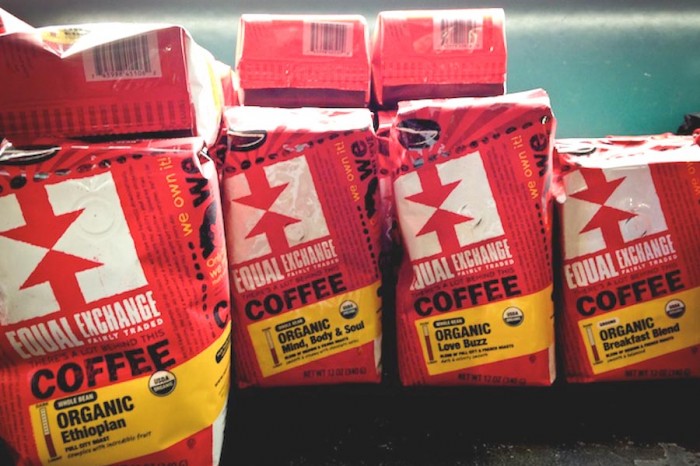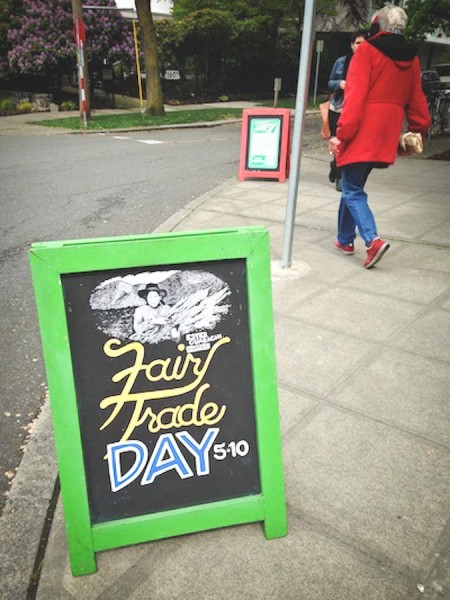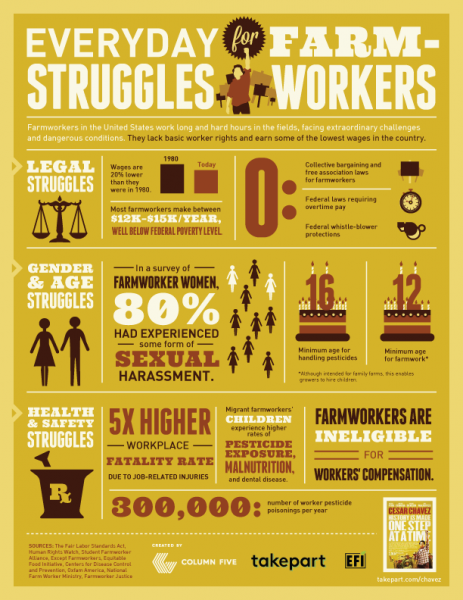
In a confusing world of food marketing where ‘gluten-free’ is mistaken as a panacea for health and ‘free-range’ might mean that a chicken stepped outside of it’s cage into a patch of grass for ten minutes, we have every right to believe that we’re misinformed about what we eat.
It’s hard enough out there for a well-meaning grocery shopper. People in Seattle are still scratching their heads over the recent GMO debate (spoiler alert: they’re probably harmless), and shoppers must wrestle with the moral dilemma of organic vs. local vs. price — and for the love of god, remembering to bring re-usable bags.
Sadly, all of this contemplation still completely leaves out the crucial issues of labor. In a coffee-and-chocolate addicted city that’s now recognized as a leader in the worker’s rights movement, we ought to know more about how the people who produce our food are treated.
Just because a food is healthy to eat (‘fresh’, ‘gluten-free’, ‘low-fat’), or even sustainably grown (‘organic’, ‘GMO-free’) or low on carbon footprint (‘local’), it doesn’t tell us anything about the wages or conditions that the people who helped produce it were subject to.
Thanks to a new fair trade labeling evaluation unrolling on World Fair Trade Day this Saturday, we have even more factors to consider when we think about where our dinner comes from.

The Domestic Fair Trade Association (DFTA), a Seattle-based coalition dedicated to justice in the food and farming system, has taken on the daunting task of evaluating and demystifying various fair trade labeling systems, which unlike organics, have no federal standards regulating them.
The goal, according to DFTA Executive Director Colette Cosner, is to maintain the integrity of the labeling — keeping it from going the route of other food labels, watered down by big companies like Wal-Mart, which launched a brand of price-cut organics last month.
She calls the process “fair-washing” — the trade-and-labor iteration of “green-washing,” whereby profit-driven companies market products as environmentally friendly to appeal to a set of marketable environmental values.
Confused yet?
Before you decide to revolt and eat nothing but cheese puffs from now until eternity, take a look at the DFTA’s bottom line results, which aim to create more a holistic standard for labels that get at the true meaning of what more and more people want in their food.
It’s a step in the right direction, for a grossly overlooked piece of a food puzzle where ‘organic’ and ‘local’ get far more airtime.
But until the fair trade label is more widespread and holds more clout for the average shopper, it may just be one more thing for the well-meaning among us to to contemplate in the grocery aisle.
Either way, the evaluation is a great starting point to open the conversation about the difference between food justice, food trends, and just plain bad marketing.
Though the DFTA focuses on domestic trade, they recognize the connection between strong local agricultural communities at home and abroad. Many partners in the alliance focus on global trade, like farmworker organizations fighting for migrant laborers, and stores like Central Co-op, which carries a huge line of fair trade options for globally sourced items.

Another Seattle-based organization, Community Alliance for Global Justice (CAGJ), is supportive of the move towards transparency and more public discourse. Executive Director Heather Day called the DFTA evaluations a “more nuanced” and “comprehensive” way of keeping the fair trade name from becoming obsolete.
“It re-injects faith in the potential of that kind of system,” Day said of the evaluation results.
The DFTA focused on an impressive set of criteria for evaluating six different fair trade labeling systems, including everything from animal welfare to fair pricing and sustainable agriculture practices. The list also includes the nitty-gritty items we didn’t even think to think of — affordable credit for farmers, responsible marketing, and rights of indigenous peoples.
The evaluation system is unique in that it brought actual food producers to the table to approve the results using consensus decision-making.
“The process of consensus mirrors what we believe is missing from the sustainable agriculture movement, which is collaboration across sectors,” said Cosner.

Though all of the six of labeling systems DFTA rated had pros and cons, if there was a clear winner, it was the mostly unknown ‘Food Justice Certified’ label, created by the Agricultural Justice Project after four years of gathering input from farmers and non-profits.
Just because it’s thorough doesn’t mean it’s prevalent — currently there are only a handful of farms certified by the label in the U.S. (there are over 70 in Canada). Most recognizable under the AJP label is Swanton Berry Farms, the first strawberry farm in the U.S. to sign a contract with the United Farmworkers of America, and to offer stock options to its employees.
According to both Cosner and Day, it’s not just about being a conscious consumer, as the organic movement touts, but a truly engaged citizen, honing in on immigration, trade, and agricultural policy.
In an article that came out in last week’s Seattle’s Child, Seattle-based hip-hip artist Geo and his wife Chera Amlag described some of the fruits of their social-justice parenting approach: before each meal their eldest son thanks all of the people who helped make his meal possible, from farmworkers to truck drivers to grocery-store baggers. Kids like theirs will be informed on the issues before they ever open a bank account, which is exactly the point.
Local organizations like CAGJ are taking on the larger issues captured by these labels, educating the public and supporting farmers like the ones who recently rallied in the Skagit Valley, to organize for their cause. They also have a Farm Bill Action Group, to educate about the piece of legislation that affects much of the policy around food.
At the end of the day, buying food with the ‘right’ label is not meant to be a litmus test for progressivism. But without the right information, we can easily end up contradicting our most deeply held values with the groceries we buy.
Hopefully tools like this one will make it that much easier to do a little better.
Looking to learn more about fair trade? Saturday’s the day! Check out local resources through CAGJ, the DFTA, and the Fair World Project. Join CAGJ, Got Green, and the Seattle Labor Chorus in Hillman City to celebrate worker’s culture, or visit Central Co-op in Capitol Hill to hear from fair trade vendors and advocacy organizations.


Thanks for the article shedding light on Fair Trade labeling and the new DFTA assessment. Full disclosure, i work at Central Co-op which is mentioned in your article, and Central Co-op is a member of the DFTA.
Regarding your editorial “spoiler alert” on the “probable harmlessness” of GMOs, surely you must be aware that concerns about GMOs go far beyond concerns over their health impact on eaters.
Serious ecological concerns, and serious concerns over corporate ownership of patented genetic material and the resulting control of seed stock and the food supply, should be highlighted alongside your brief dismissal of any health concerns.
Also, health concerns go beyond a simple focus on whether ingesting the modified foods could produce allergic or other effects, and include concerns over the massive increase in the spraying of the glyphosate herbicide that many of the GMO foods are engineered to survive. Researchers have identified glyphosate in the blood and urine of consumers. Humans are decidedly not engineered to be “RoundUp Ready.”
With the inevitably reduced effectiveness of the massively over-sprayed glyphosate, newer GMOs are now being engineered to survive application of the more toxic herbicide 2-4-D, a component of the infamous war-time herbicide cocktail Agent Orange. This is because, as predicted by scientists, “super weeds” have quickly evolved resistance to glyphosate, so the corporations that own the seed patents are escalating their GMO herbicide arms race, with the development of 2-4-D resistant “super weeds” the inevitable result. Where will this herbicide arms race end?
Dismissal of health concerns that people have with GMOs, especially when presented without acknowledging the many other concerns shared by millions of consumers regarding the proliferation of unlabeled genetically engineered foods in the marketplace, misses a chance to better inform your readers.
If your comment reflects a genuine unfamiliarity with these many concerns, please check out the Center for Food Safety’s web site, which has extensive material regarding every area of consumer concern with GMOs.
Thanks again for your work.
Hi Webster,
Thanks for weighing in. As a publication we’re committed to informing our readers re the nuances of the GMO debate, and while that wasn’t the focus of this particular article, our contributors have done some great articles in the past where it was:
https://seattleglobalist.com/2013/07/03/what-washington-should-know-about-gmos/14571
https://seattleglobalist.com/2013/11/03/immigrant-farm-workers-522-gmo-food-labeling/17545